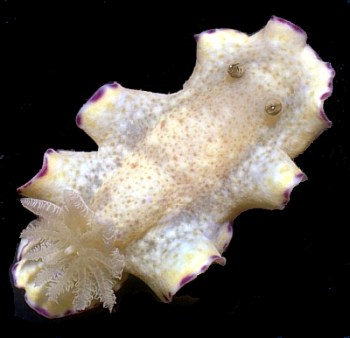
Chromodoris alius
Rudman, 1987
Order: NUDIBRANCHIA
Suborder: DORIDINA
Superfamily: EUDORIDOIDEA
Family: Chromodorididae
DISTRIBUTION
Western Indian Ocean
PHOTO
Holotype. Ocean Rd. Beach, entrance to harbour, Dar es Salaam, Tanzania, September 1973. 40mm long alive. Photo: Bill Rudman.
Note added 7 March 2005: see message #13260 suggesting this species may be synonymous with C. aureopurpurea, C. albopustulosa, and C. rufomaculata, which would give it a wide Indo-West Pacific distribution.
The mantle is creamy-white with six irregular grayish translucent patches arranged as in C. rufomaculata but interconnected with other elongate translucent patches around the inner part of the mantle skirt. All over the mantle are small translucent pits each with a golden-yellow spot giving the mantle an uneven pitted appearance. At the mantle edge is a band of purple elongate marks and inside this a diffuse submarginal band of milky yellow.
The rhinophore stalks are translucent white and the clubs are dark brown or black with white edgings. The gills are translucent with white edging. The underside is all white except for the mantle edge where the purple shows through from the dorsum. The wide mantle skirt is thrown into a number of folds down each side. The gills are simple.
Chromodoris alius is very similar in colour to both C. rufomaculata and C. aureopurpurea. It differs from C. rufomaculata in that the golden yellow spots are each at the base of a translucent pit in C. alius, whereas in C. rufomaculata they are, if anything, slightly raised and usually on the white background pigmentation.
It differs from C. aureopurpurea in that it has a continuous yellow band inside the row of purple spots at the mantle margin, while in C. aureopurpurea each purple spot has a yellow cap around its inside edge. Also, in C. aureopurpurea the purple spots on the mantle are larger. The radula of C. alius is more like that of C. aureopurpurea than that of C. rufomaculata, but differs from the former in details of the denticulation.
The species has been recorded from Sth Africa, Tanzania and Reunion Is. suggesting that this species is an Indian Ocean endemic. The similarities in colour pattern and radular morphology to C. aureopurpurea suggest that they are a pair of closely related species, C. aureopurpurea being endemic to the western Pacific and C. alius to the western Indian Ocean.
Reference:
• Rudman, W.B. (1987) The Chromodorididae (Opisthobranchia: Mollusca) of the Indo-West Pacific: Chromodoris epicuria, C. aureopurpurea, C. annulata, C. coi and Risbecia tryoni colour groups. Zoological Journal of the Linnean Society, 90: 305-407.
Rudman, W.B., 2000 (June 22) Chromodoris alius Rudman, 1987. [In] Sea Slug Forum. Australian Museum, Sydney. Available from http://www.seaslugforum.net/find/chroaliu
Related messages
Re: Juvenile Chromodoris alius from Reunion Island
February 14, 2008
From: Hugues Flodrops
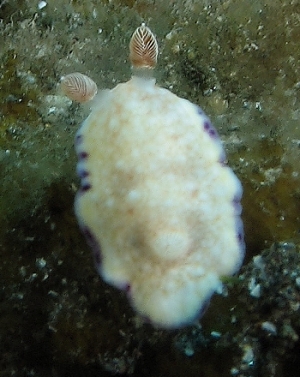
Concerning message #12900:
Dear Bill and Marina,
I'm happy to identify this chromodorid as Chromodoris alius. I had some difficulties with the little size, less 10 mm.
I'm pretty sure of the identification because it's an Indian Ocean endemic species, and I saw "Poddubeskaia picture" looking similar. I hope it's interesting for the forum to have a juvenile record from Reunion.
Locality: Etang-Salé "Petit Brisant", 5 metres, Reunion Island, Indian Ocean, 10 October 2007, Muddy. Length: 8 mm. Photographer: Hugues Flodrops.
The rhinophore stalks are translucent like your description.
Thanks again.
Regards.
Hugues.
hugues.flodrops@wanadoo.fr
Flodrops, H., 2008 (Feb 14) Re: Juvenile Chromodoris alius from Reunion Island. [Message in] Sea Slug Forum. Australian Museum, Sydney. Available from http://www.seaslugforum.net/find/21377Thanks Hugues,
I agree with your identification
Best wishes,
Bill Rudman
Unidentified Chromodoris feeding & damaged
October 15, 2005
From: Colin Ogden
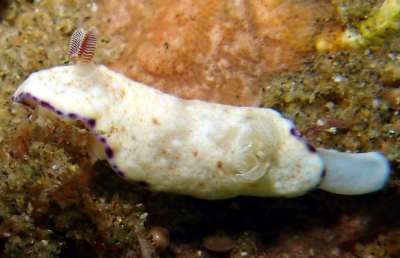
Hi Bill,
Tthis morning I came across these 2 nudis, which I have seen often, but I can't ID them. In these photos the first one is feeding on a sponge, but the second one, about 10 metres away has one of its rhinopores missing. We occasionally see nudis with extensive physical damage but they seem to survive regardless, so they must be fairly tough little things. This is the first one I have seen with a rhinopore missing.
Locality: Sodwana Bay, South Africa, Indian Ocean. Depth: 10 metres. Length: 5 cm. 12 October 2005. Sponge algae reef. Photographer: Colin Ogden
Thanks for all the help you have given me. I really do appreciate it. As part of Marine week next week we will be putting together a slide show of all the sea slugs we find at Sodwana Bay and so far it appears that we have photos of close to 150 different species. Is this a large number for one area or is it about what we should expect?
regards
Colin
scubaco@iafrica.com
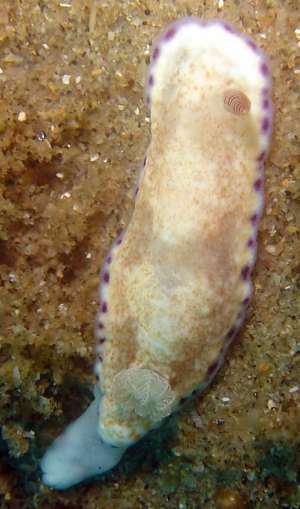
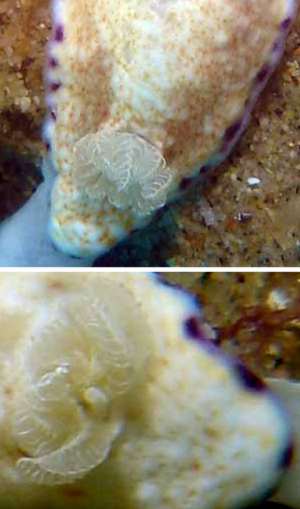
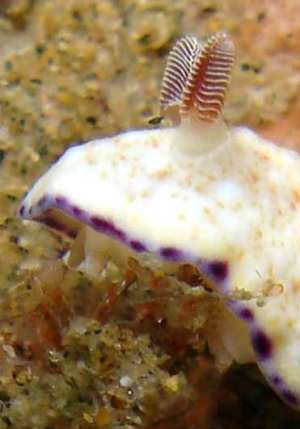
Dear Colin,
This is a species I named Chromodoris alius, but as you will see on the Fact Sheet I have some doubts about just how many species there are in this colour group. I sometimes have doubts about other people's new species, so at least this shows I am not biased. One of your animals certainly looks as though something has removed a rhinophore, but as you say they seem to survive quite a lot of damage.
I'm afraid the first one is not feeding. In the close-up it certainly looks like it is taking a big bite, but the pair of 'fangs' at the top are in fact its oral tentacles. If it were feeding the buccal bulb would be emerging from between those tentacles. However I much prefer to get photos that turn out not to show feeding, than for you to hesitate and not send me a feeding record because you weren't sure.
150 species is a good haul for the time you have been looking. Terry Gosliner recorded about 270 species in his book, but that include the southern cape fauna as well as the more tropical element on the Indian Ocean coast. I would guess that you will gradually double that number as tropical visitors arrive as larvae from further north. If you start targeting special habitats, such as hydroids, and particular algae, or small things etc etc you will start to find another new group to increase your numbers. You are in fact sampling the Indian Ocean - it won't all be there at once, but over a number of years, if you retain your interest you will be reguallry rewarded with new records.
Best wishes,
Bill Rudman
Chromodoris rufomaculata? from Sri Lanka
February 19, 2005
From: Marina Poddubetskaia
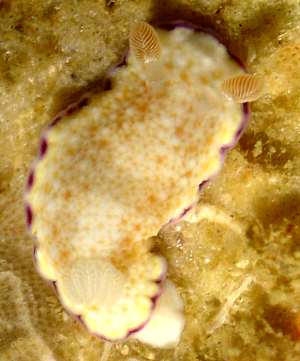
Dear Bill,
Here is a species from my recent trip to Sri Lanka. I'm hesitating between Chromodoris rufomaculata and Chromodoris alius. From your description on the Forum I feel it is C. rufomaculata, but I'd like it to be confirmed, please.
Locality: 'Cave', Hikkaduwa, Sri Lanka. Indian Ocean. Depth: 8 m. Length: 12 mm. 07 November 2004. found under a rock. Photos: Marina Poddubetskaia - Nembro website
Thank you in advance for your help.
Best wishes,
Marina.
nembro@nembro.info
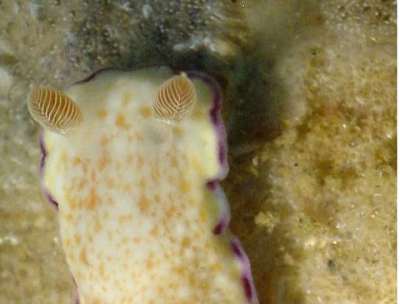
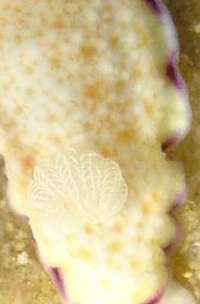
Dear Marina,
This is Chromodoris alius. Two colour characters distinguish from the similarly coloured species. Just inside the band of purple spots around the edge is a region of the mantle with diffuse yellow spots. The spots over the rest of the mantle are a slightly browner colour and are irregular in size and shape and also seem to be in a sunken pit. In C. rufomaculata all the yellow spots on the mantle are of similar size and colour. This is the first record I know of the species from Sri Lanka.
Best wishes,
Bill Rudman
Chromodorid from Sodwana, Sth Africa
February 5, 2004
From: Charles Rowe
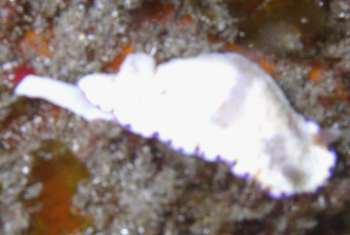
Hi Bill,
Here is a nudi which I photographed in January at Sodwana in Kwa Zulu Natal, South
Africa.
Stringer Reef, Sodwana, 7 January 2004
It is not a very good photo but is the best I have. Maybe you can still identify it.
Charles Rowe
bumff@mweb.co.za
Rowe, C., 2004 (Feb 5) Chromodorid from Sodwana, Sth Africa. [Message in] Sea Slug Forum. Australian Museum, Sydney. Available from http://www.seaslugforum.net/find/12097Dear Charles,
This is the same as a photo of Valda Fraser's which I tentatively identified as Chromodoris alius but which maybe a form of C. aureopurpurea if that species proves to live in the Indian Ocean as well as the Pacific. Unfortunately neither your photo or Valda's are clear enough to make out any details
Best wishes
Bill Rudman
Chromodoris alius from South Africa
November 21, 2001
From: Valda Fraser

Dear Bill
Would you be happy if I said this one is Chromodoris alius?
Locality: Pumula, south coast KwaZulu-Natal, South Africa, 28m
Date: Oct 2001
Size: 20 mmm
Regards
Valda Fraser
valdafraser@mweb.co.za
Fraser, V., 2001 (Nov 21) Chromodoris alius from South Africa. [Message in] Sea Slug Forum. Australian Museum, Sydney. Available from http://www.seaslugforum.net/find/5607Dear Valda,
Yes this is Chromodoris alius. In Terry Gosliner's book Nudibranchs of Southern Africa (1987) he has this as Chromodoris sp. 7. It seems the brownish specks and patches are more noticeably coloured than the specimens I have illustrated from Tanzania.
Best wishes,
Bill Rudman
Chromodoris alius? from South Africa
September 18, 2000
From: Valda Fraser
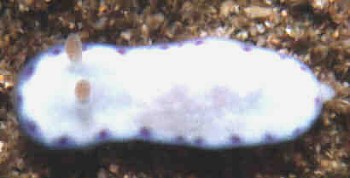
Dear Bill
I found this little one in an inshore pool. I have no ideas as regards identification and hope you will be able to help. Thanks.
Locality: Mpande, Transkei, SOUTH AFRICA - intertidal zone.
Date: June 2000
Size: 18mm
Regards
Valda Fraser
iti04937@mweb.co.za
Fraser, V., 2000 (Sep 18) Chromodoris alius? from South Africa. [Message in] Sea Slug Forum. Australian Museum, Sydney. Available from http://www.seaslugforum.net/find/2665Dear Valda,
It's a little bit hard to be sure since the colour pattern isn't showing too clearly. I suspect it is Chromodoris alius.
Best wishes,
Bill Rudman.
What is Chromodoris alius?
June 23, 2000
From: Atsushi Ono
Dear Bill,
Thank you for comments about Colpodaspis sp. 2.
Now I don't know the difference between Chromodoris rufomaculata Pease, 1871
and C. alius Rudman, 1987. I think the C. alius in my book is actually C. rufomaculata.
Would you add the photo of Chromodoris alius to the Forum?
Sincerely,
Atsushi Ono
ononini@cosmos.ne.jp
Ono, A., 2000 (Jun 23) What is Chromodoris alius?. [Message in] Sea Slug Forum. Australian Museum, Sydney. Available from http://www.seaslugforum.net/find/2611Dear Atsushi,
Yes the C. alius in your book is C. rufomaculata. I have had the photo prepared for a C. alius page for some time, so I have added it today.
The only records I have for it are from the western Indian Ocean.
Best wishes,
Bill Rudman.
